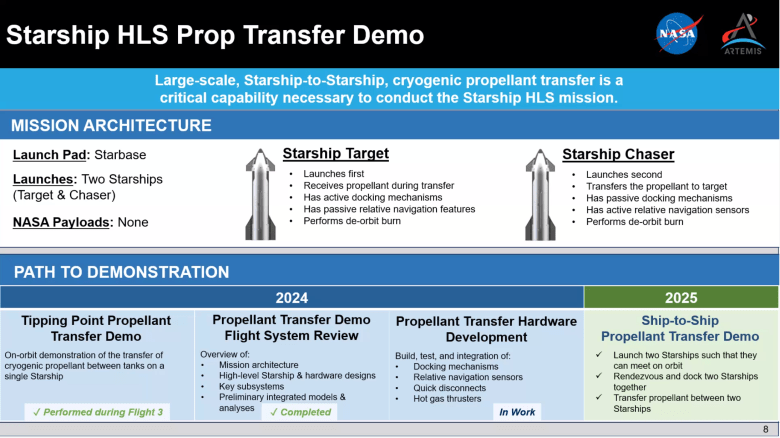
A test of transferring propellants between tanks on Starship during its March test flight was a success, NASA says. Credit: SpaceX
La NASA dice que una prueba de transferencia de propulsores entre tanques en Starship durante su vuelo de prueba de marzo fue un éxito. Crédito: SpaceX
WASHINGTON — NASA says SpaceX is on track to demonstrate in-space refueling of Starship next year, a critical technology for returning humans to the lunar surface using that vehicle.
WASHINGTON – La NASA dice que SpaceX está en camino de demostrar el reabastecimiento de combustible en el espacio de Starship el próximo año, una tecnología crítica para que los humanos regresen a la superficie lunar utilizando ese vehículo.
Speaking to the NASA Advisory Council’s Human Exploration and Operations Committee April 26, Amit Kshatriya, NASA deputy associate administrator for the Moon to Mars Program, said SpaceX achieved one step towards refueling of Starship with a demonstration on the latest Starship test flight March 14.
En declaraciones al Comité de Operaciones y Exploración Humana del Consejo Asesor de la NASA el 26 de abril, Amit Kshatriya, administrador asociado adjunto de la NASA para el Programa Luna a Marte, dijo que SpaceX logró un paso hacia el reabastecimiento de combustible de Starship con una demostración en el último vuelo de prueba de Starship el 14 de marzo.
During that flight, SpaceX performed an in-flight propellant transfer demonstration under a NASA Tipping Point contract awarded in 2020. SpaceX planned to transfer at least 10 metric tons of liquid oxygen from a header tank to the main tank within the Starship upper stage while in space.
Durante ese vuelo, SpaceX realizó una demostración de transferencia de propulsor en vuelo en virtud de un contrato Tipping Point de la NASA otorgado en 2020. SpaceX planeaba transferir al menos 10 toneladas métricas de oxígeno líquido desde un tanque principal al tanque principal dentro de la etapa superior de Starship mientras estaba en espacio.
While SpaceX said the day of the flight that it performed the demonstration, neither the company nor NASA provided any updates since then. At the advisory committee meeting, though, Kshatriya said the test appeared to go well.
Si bien SpaceX dijo el día del vuelo que realizó la demostración, ni la compañía ni la NASA proporcionaron ninguna actualización desde entonces. Sin embargo, en la reunión del comité asesor, Kshatriya dijo que la prueba parecía haber ido bien.
“On Flight 3, they did an intertank transfer of cryogens, which was successful by all accounts,” he said, adding that analysis of the test is ongoing.
"En el vuelo 3, hicieron una transferencia de criógenos entre tanques, que fue exitosa en todos los sentidos", dijo, y agregó que el análisis de la prueba está en curso.
The next major milestone is a demonstration planned for 2025 where two Starships will dock in orbit, with one transferring propellants to the other. Plans for that have passed a flight system review, according to a slide he presented at the meeting, examining the overall mission architecture and key subsystems, among other topics.
El próximo gran hito es una demostración prevista para 2025 en la que dos Starships acoplarán en órbita y una transferirá propulsores a la otra. Los planes para eso han pasado una revisión del sistema de vuelo, según una diapositiva que presentó en la reunión, examinando la arquitectura general de la misión y los subsistemas clave, entre otros temas.
In that mission, a “target” Starship will launch first and go into orbit, followed three to four weeks later by a “chaser” Starship. The two vehicles will dock with the chaser transferring propellants to the target. After the demonstration, the two Starships will undock and deorbit.
En esa misión, una nave estelar "objetivo" se lanzará primero y entrará en órbita, seguida tres o cuatro semanas después por una nave estelar "persecudora". Los dos vehículos se acoplarán con el cazador transfiriendo propulsores al objetivo. Después de la demostración, las dos Starships se desacoplarán y saldrán de órbita.
Kshatriya said SpaceX has some work ahead of that test, including understanding the slosh of propellants in the tanks as Starship maneuvers as well as the amount of “settling thrust” needed once the vehicles are docked to ensure propellant flows between them.
Kshatriya dijo que SpaceX tiene trabajo por delante antes de esa prueba, incluida la comprensión del chapoteo de los propulsores en los tanques como maniobras de Starship, así como la cantidad de "empuje de asentamiento" necesario una vez que los vehículos están acoplados para garantizar que el propulsor fluya entre ellos.

A slide from Kshatriya’s presentation showing plans for the Starship propellant transfer demo.
Una diapositiva de la presentación de Kshatriya que muestra los planes para la demostración de transferencia de propulsor Starship.
“The point of their flight test program before we do this is to make sure they fully understand the slosh dynamics, fully understand how the ullage is being maintained, what the settling thrust needs to be,” he said. “We’ve gone through it with them in terms of their plan for this. It’s a good plan.”
"El objetivo de su programa de pruebas de vuelo antes de que hagamos esto es asegurarnos de que comprendan completamente la dinámica del chapoteo, comprendan completamente cómo se mantiene el espacio vacío y cuál debe ser el empuje de asentamiento", dijo. “Lo hemos analizado con ellos en términos de su plan para esto. Es un buen plan”.
Propellant transfer technology is essential to SpaceX’s plans for Starship missions beyond low Earth orbit, including the Human Landing System (HLS) version of Starship that will be used to land astronauts on the moon starting with the Artemis 3 mission, currently scheduled for no earlier than September 2026. Multiple Starship launches will transfer propellant into a depot in low Earth orbit that will then be used to fuel the HLS Starship, sending it to the moon.
La tecnología de transferencia de propulsor es esencial para los planes de SpaceX para las misiones Starship más allá de la órbita terrestre baja, incluida la versión Human Landing System (HLS) de Starship que se utilizará para llevar astronautas a la luna a partir de la misión Artemis 3, actualmente programada para no antes de Septiembre de 2026. Múltiples lanzamientos de Starship transferirán propulsor a un depósito en órbita terrestre baja que luego se utilizará para alimentar el HLS Starship y enviarlo a la luna.
The exact number of refueling launches has been the subject of controversy, with estimates going as high as nearly 20. Kshatriya did not give a number of launches in his presentation, suggesting more work needs to be done to better understand the refueling process.
El número exacto de lanzamientos de reabastecimiento de combustible ha sido objeto de controversia, con estimaciones que llegan a casi 20. Kshatriya no dio un número de lanzamientos en su presentación, sugiriendo que es necesario trabajar más para comprender mejor el proceso de reabastecimiento de combustible.
He said the company is working to understand factors like boiloff of propellants and leakage, as well as how much propellant can be effectively transferred from a Starship. “All of that is stuff that they know is in front of them, but all of that is stuff that’s in the plan to go characterize,” he said. “That will then derive the answer.”
He said the company is working to understand factors like boiloff of propellants and leakage, as well as how much propellant can be effectively transferred from a Starship. “All of that is stuff that they know is in front of them, but all of that is stuff that’s in the plan to go characterize,” he said. “That will then derive the answer.”
The in-space propellant transfer test will be followed by an uncrewed demonstration mission of the HLS Starship, including fueling the vehicle and sending it to the moon for a landing. That mission will also feature an “ascent demo” not originally included in the plan, he said, to prove Starship can lift off the lunar surface.
A la prueba de transferencia de propulsor en el espacio le seguirá una misión de demostración sin tripulación del HLS Starship, que incluirá alimentar el vehículo y enviarlo a la luna para un aterrizaje. Esa misión también incluirá una “demostración de ascenso” que no estaba incluida originalmente en el plan, dijo, para demostrar que Starship puede despegar de la superficie lunar.
“Full & rapid reusability of booster & ship and orbital refilling of ship are the 2 fundamental technologies we aim to solve by the end of next year,” Elon Musk, chief executive of SpaceX, posted on social media April 26, responding to another post about Kshatriya’s presentation. “Those are the critical pieces necessary to make life multiplanetary.”
"La reutilización completa y rápida del propulsor y la nave y el relleno orbital de la nave son las dos tecnologías fundamentales que pretendemos resolver para finales del próximo año", publicó Elon Musk, director ejecutivo de SpaceX, en las redes sociales el 26 de abril, en respuesta a otra publicación. sobre la presentación de Kshatriya. "Esas son las piezas críticas necesarias para que la vida sea multiplanetaria".


 TheNewsCrypto
TheNewsCrypto TheNewsCrypto
TheNewsCrypto DogeHome
DogeHome Crypto Daily™
Crypto Daily™ Crypto Daily™
Crypto Daily™ Crypto Daily™
Crypto Daily™ Optimisus
Optimisus CoinsProbe
CoinsProbe CryptoNewsLand
CryptoNewsLand






















